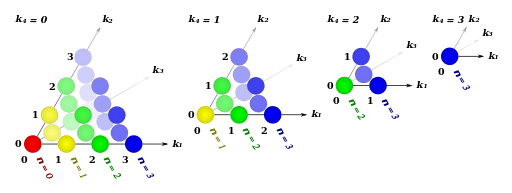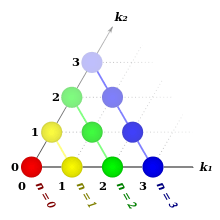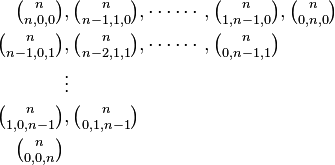Pascal's simplex
In mathematics, Pascal's simplex is a generalisation of Pascal's triangle into arbitrary number of dimensions, based on the multinomial theorem.
Generic Pascal's m-simplex
Let m (m > 0) be a number of terms of a polynomial and n (n ≥ 0) be a power the polynomial is raised to.
Let  denote a Pascal's m-simplex. Each Pascal's m-simplex is a semi-infinite object, which consists of an infinite series of its components.
denote a Pascal's m-simplex. Each Pascal's m-simplex is a semi-infinite object, which consists of an infinite series of its components.
Let  denote its nth component, itself a finite (m − 1)-simplex with the edge length n, with a notational equivalent
denote its nth component, itself a finite (m − 1)-simplex with the edge length n, with a notational equivalent  .
.
nth component
 consists of the coefficients of multinomial expansion of a polynomial with m terms raised to the power of n:
consists of the coefficients of multinomial expansion of a polynomial with m terms raised to the power of n:
where  .
.
Example for 
Pascal's 4-simplex (sequence A189225 in OEIS), sliced along the k4. All points of the same color belong to the same n-th component, from red (for n = 0) to blue (for n = 3).

Specific Pascal's simplices
Pascal's 1-simplex
 is not known by any special name.
is not known by any special name.

nth component
 (a point) is the coefficient of multinomial expansion of a polynomial with 1 term raised to the power of n:
(a point) is the coefficient of multinomial expansion of a polynomial with 1 term raised to the power of n:
Arrangement of 
which equals 1 for all n.
Pascal's 2-simplex
 is known as Pascal's triangle (sequence A007318 in OEIS).
is known as Pascal's triangle (sequence A007318 in OEIS).

nth component
 (a line) consists of the coefficients of binomial expansion of a polynomial with 2 terms raised to the power of n:
(a line) consists of the coefficients of binomial expansion of a polynomial with 2 terms raised to the power of n:
Arrangement of 
Pascal's 3-simplex
 is known as Pascal's tetrahedron (sequence A046816 in OEIS).
is known as Pascal's tetrahedron (sequence A046816 in OEIS).

nth component
 (a triangle) consists of the coefficients of trinomial expansion of a polynomial with 3 terms raised to the power of n:
(a triangle) consists of the coefficients of trinomial expansion of a polynomial with 3 terms raised to the power of n:
Arrangement of 
Properties
Inheritance of components
 is numerically equal to each (m − 1)-face (there is m + 1 of them) of
is numerically equal to each (m − 1)-face (there is m + 1 of them) of  , or:
, or:
From this follows, that the whole  is (m + 1)-times included in
is (m + 1)-times included in  , or:
, or:
Example




1 1 1 1
1 1 1 1 1 1 1 1 1 1
1 1 2 1 1 2 1 1 2 1 2 2 1 2 2 2 2 2 1 1
1 1 3 3 1 1 3 3 1 1 3 3 1 3 6 3 3 3 1 3 6 3 3 6 3 6 6 3 3 3 3 3 3 1 1
For more terms in the above array refer to (sequence A191358 in OEIS)
Equality of sub-faces
Conversely,  is (m + 1)-times bounded by
is (m + 1)-times bounded by  , or:
, or:
From this follows, that for given n, all i-faces are numerically equal in nth components of all Pascal's (m > i)-simplices, or:
Example
The 3rd component (2-simplex) of Pascal's 3-simplex is bounded by 3 equal 1-faces (lines). Each 1-face (line) is bounded by 2 equal 0-faces (vertices):
2-simplex 1-faces of 2-simplex 0-faces of 1-face
1 3 3 1 1 . . . . . . 1 1 3 3 1 1 . . . . . . 1
3 6 3 3 . . . . 3 . . .
3 3 3 . . 3 . .
1 1 1 .
Also, for all m and all n:
Number of coefficients
For the nth component ((m − 1)-simplex) of Pascal's m-simplex, the number of the coefficients of multinomial expansion it consists of is given by:
that is, either by a sum of the number of coefficients of an (n − 1)th component ((m − 1)-simplex) of Pascal's m-simplex with the number of coefficients of an nth component ((m − 2)-simplex) of Pascal's (m − 1)-simplex, or by a number of all possible partitions of an nth power among m exponents.
Example
| m-simplex | nth component | n = 0 | n = 1 | n = 2 | n = 3 | n = 4 | n = 5 |
|---|---|---|---|---|---|---|---|
| 1-simplex | 0-simplex | 1 | 1 | 1 | 1 | 1 | 1 |
| 2-simplex | 1-simplex | 1 | 2 | 3 | 4 | 5 | 6 |
| 3-simplex | 2-simplex | 1 | 3 | 6 | 10 | 15 | 21 |
| 4-simplex | 3-simplex | 1 | 4 | 10 | 20 | 35 | 56 |
| 5-simplex | 4-simplex | 1 | 5 | 15 | 35 | 70 | 126 |
| 6-simplex | 5-simplex | 1 | 6 | 21 | 56 | 126 | 252 |
Interestingly, the terms of this table comprise a Pascal triangle in the format of a symmetric Pascal matrix.
Symmetry
(An nth component ((m − 1)-simplex) of Pascal's m-simplex has the (m!)-fold spatial symmetry.)
Geometry
(Orthogonal axes k_1 ... k_m in m-dimensional space, vertices of component at n on each axe, the tip at [0,...,0] for n=0.)
Numeric construction
(Wrapped n-th power of a big number gives instantly the n-th component of a Pascal's simplex.)

where  .
.












